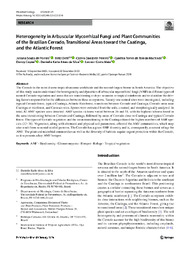Heterogeneity in arbuscular mycorrhizal fungi and plant communities of the Brazilian Cerrado, transitional areas toward the Caatinga, and the Atlantic Forest.
Heterogeneity in arbuscular mycorrhizal fungi and plant communities of the Brazilian Cerrado, transitional areas toward the Caatinga, and the Atlantic Forest.
Author(s): PONTES, J. S. de; OEHL, F.; PEREIRA, C. D.; MACHADO, C. T. de T.; COYNE, D.; SILVA, D. K. A. da; MAIA, L. C.
Summary: Abstract: The Cerrado is the most diverse tropical savanna worldwide and the second-largest biome in South America. The objective of this study was to understand the heterogeneity and dynamics of arbuscular mycorrhizal fungi (AMF) in different types of natural Cerrado vegetation and areas that are transitioning to dryer savannas or tropical rainforests and to elucidate the driving factors responsible for the differences between these ecosystems. Twenty-one natural sites were investigated, including typical Cerrado forest, typical Caatinga, Atlantic Rainforest, transitions between Cerrado and Caatinga, Cerrado areas near Caatinga or rainforest, and Carrasco sites. Spores were extracted from the soils, counted, and morphologically analyzed. In total, 82 AMF species were detected. AMF species richness varied between 36 and 51, with the highest richness found in the area transitioning between Cerrado and Caatinga, followed by areas of Cerrado close to Caatinga and typical Cerrado forest. The types of Cerrado vegetation and the areas transitioning to the Caatinga shared the highest numbers of AMF species (32–38). Vegetation, along with chemical and physical soil parameters, affected the AMF communities, which may also result from seasonal rainfall patterns. The Cerrado has a great AMF diversity and is, consequently, a natural refuge for AMF. The plant and microbial communities as well as the diversity of habitats require urgent protection within the Cerrado, as it represents a key AMF hotspot.
Publication year: 2024
Types of publication: Journal article
Unit: Embrapa Cerrados
Observation
Some of Embrapa's publications are published as ePub files. To read them, use or download one of the following free software options to your computer or mobile device. Android: Google Play Books; IOS: iBooks; Windows and Linux: Calibre.
Access other publications
Access the Agricultural Research Database (BDPA) to consult Embrapa's full library collection and records.
Visit Embrapa Bookstore to purchase books and other publications sold by Embrapa.

